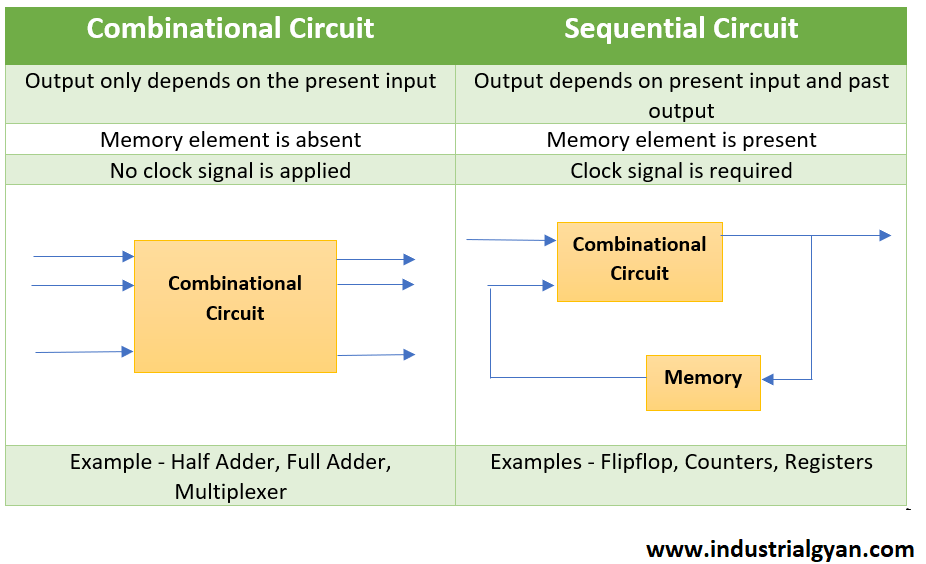Introduction
Combinational circuits do not employ any feedback loops or memory elements. They are designed using logic gates and perform operations directly on the inputs to generate the output. In contrast, sequential circuits utilize feedback loops and memory elements like flip-flops or registers and difference between combinational and sequential circuit.
Table 1: Outline of the Article
| Heading | Subheading |
|---|---|
| Introduction | – Definition of combinational circuits <br>- Definition of sequential circuits |
| Key Differences | – Nature of output <br>- Feedback and memory elements <br>- Timing considerations |
| Combinational Circuits | – Definition and characteristics <br>- Examples <br>- Applications |
| Sequential Circuits | – Definition and characteristics <br>- Examples <br>- Applications |
| Comparison | – Output behavior <br>- Design complexity <br>- Applications |
| Conclusion | – Recap of differences <br>- Importance in digital systems |
Table 2: Article
Introduction
Combinational and sequential circuits are two fundamental components in digital systems. While both serve distinct purposes, they exhibit notable differences in terms of output behavior, feedback, and timing considerations. In this article, we will explore the dissimilarities between these two types of circuits and their applications in various domains.

Key Differences
Nature of Output
Combinational circuits produce outputs solely based on their current input values. These circuits do not have any internal memory elements, and the output depends only on the present combination of inputs. On the other hand, sequential circuits have outputs that depend not only on the present inputs but also on the current state of the circuit. They incorporate memory elements that retain information, enabling them to have outputs influenced by past inputs and states.
Feedback and Memory Elements
Combinational circuits do not employ any feedback loops or memory elements. They are designed using logic gates and perform operations directly on the inputs to generate the output. In contrast, sequential circuits utilize feedback loops and memory elements like flip-flops or registers. The feedback allows the circuits to store and remember information, latching current leading to the concept of “sequential” behavior.
Timing Considerations
Timing plays a crucial role in digital circuits, and it differs between combinational and sequential circuits. Combinational circuits are instantaneous in nature, providing output as soon as the input values stabilize. In contrast, sequential circuits have inherent delays due to the presence of memory elements. These delays are a result of the time required for the circuits to transition from one state to another. Proper consideration of timing is vital in sequential circuits to ensure their stability and functionality.
Combinational Circuits
Combinational circuits are digital circuits where the output is solely determined by the current input combination. They do not possess memory elements or feedback loops. Combinational circuits are built using logic gates, such as AND, OR, and NOT gates, combined in various configurations to achieve the desired logic function. These circuits find applications in arithmetic operations, data encoding and decoding, multiplexers, and many other areas where the output depends solely on the inputs at that specific instant.
Sequential Circuits
Sequential circuits are digital circuits that utilize memory elements and feedback loops. They have outputs influenced by both the current inputs and the previous state(s) of the circuit. Sequential circuits often employ flip-flops, registers, difference between combinational and sequential circuit and counters to store and manipulate information. This enables them to remember past inputs and exhibit time-dependent behavior. Sequential circuits are commonly used in applications such as memory units, microprocessors, state machines, and data storage systems.

Comparison
Output Behavior
The most significant difference between combinational and sequential circuits lies in their output behavior. Combinational circuits produce output solely based on the present inputs, making them suitable for applications where immediate response is required. Sequential circuits, with their ability to remember past states, offer a wider range of functionalities and can handle tasks that involve memory and time-dependent operations.
Design Complexity
Combinational circuits are generally simpler to design compared to sequential circuits. Since they don’t involve memory elements or feedback, their construction is relatively straightforward. Sequential circuits, on the other hand, difference between combinational and sequential circuit , require careful consideration of memory elements, feedback loops, and timing requirements. Their design complexity increases with the addition of more states and functionality.
Applications
Combinational circuits are widely used in areas such as digital arithmetic, data encoding, decoding, multiplexing, and demultiplexing. They are suitable for applications where real-time processing and immediate response are critical. Sequential circuits, with their memory and time-dependent behavior, find applications in areas such as memory units, microcontrollers, digital signal processing, and complex control systems.
Conclusion
In conclusion, combinational and sequential circuits differ significantly in terms of output behavior, feedback, and timing considerations. Combinational circuits produce output solely based on the current inputs, while sequential circuits incorporate memory elements and exhibit time-dependent behavior. Understanding these differences is crucial for designing and implementing efficient digital systems tailored to specific requirements.
FAQs (Frequently Asked Questions)
- Q: Can combinational and sequential circuits be used together in a system?
A: Yes, combinational and sequential circuits can be integrated to create complex digital systems where immediate response and time-dependent behavior are required simultaneously.
- Q: Are combinational circuits faster than sequential circuits?
A: Combinational circuits are generally faster since their output depends solely on the current inputs and doesn’t involve memory or feedback loops.
- Q: What are some examples of combinational circuits?
A: Examples of combinational circuits include adders, subtractors, multiplexers, and demultiplexers.
- Q: How do sequential circuits store information?
A: Sequential circuits store information using memory elements like flip-flops or registers, which retain data between clock cycles.
- Q: Can sequential circuits operate without clock signals?
A: No, sequential circuits rely on clock signals to synchronize their internal state transitions and ensure proper functionality.
You can follow us on LinkedIn.
You can also read this article is vibration motor

I am a highly motivated and skilled individual with a passion for Electrical engineering. I have 1 year of experience in Robotics and Electrical engineering, which has allowed me to develop a strong set of skills in PLC, Painting Robots, SCADA. I am a quick learner and am always looking for new challenges and opportunities to expand my knowledge and skills. I am a team player and enjoy working with others to achieve a common goal. Successfully completed many projects for a various clients in the automobile sector.
Thank You
